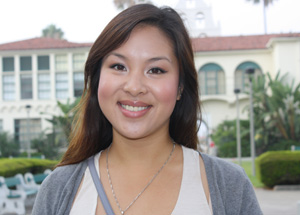What Lies Beneath
Graduate student Angie Pham researched more than 100 wells and cisterns in San Diego County.

If anyone should have known what was under the Old Quad, it’s Angie Pham (’08, ’11). Lab director and associate archeologist for a San Diego cultural resources management firm, she earned two archaeology degrees at SDSU.

Pham has spent more than her share of time below ground. For her master’s thesis, she researched more than 100 wells and cisterns in San Diego County — personally inspecting many of them — likely qualifying her as the region’s foremost expert on subterranean water structures, especially cisterns.
"A cistern is basically a reservoir or a water container and you either pump water into it or it catches rainwater and holds it for a longer period of time,” she explains. “It's usually either for fire purposes or for irrigation, but not necessarily for drinking because there's no filter or anything to clean it out."
Several weeks ago, Pham received a call from her former professor and thesis advisor, Seth Mallios, Ph.D., the chairman of SDSU’s anthropology department. He wanted to know if she was up for climbing into a manhole below the Old Quad near Hardy Tower.
“When he called me up and told me it was a cistern I was super excited,” Pham recalls. “I knew there was a water tower on campus (in Hardy Tower), but I didn't associate a cistern or a well with it because I didn't know about it when I was a student.”
Hermetically sealed and surprisingly intact
So at 7:00 a.m. on a late August morning, she found herself back on campus descending a metal ladder into a dank and pitch-black hole. Once below ground, Pham was thrilled by what her flashlight beam revealed: a giant concrete tank probably 30 feet across and 14 feet deep filled with water to within about six feet of its concrete-column-supported ceiling.
“It's surprising that it's so intact and nice versus all the old cisterns I've seen,” she says. “If you uncover them they're usually filled in with dirt or trash and they're pretty much crumbling and not intact any more compared to this one, so it's super exciting.
"It's a lot larger than I expected because from my research a lot of the historical cisterns were typically 10 feet in diameter and 15 feet in depth while this one seems much larger. The other ones I saw didn't have all the same reinforcements as this one.”
Earliest campus structure?
Mallios says he, too, was surprised by the cistern’s size and good condition. The author of an archaeological history of the campus, the professor says he had intended to explore the cistern to see what artifacts it might yield.
"I had always wanted to dig it because I had thought it would be filled with garbage from the 1930s, 40s and 50s,” he explains. “I had assumed it had stopped being used and thought it would be a good 10-year time capsule. What I didn't know was that the lid would almost hermetically seal it.”
Mallios surmises the cistern was likely the first structure built before 1931 when the old campus was moved to Montezuma Mesa. “Thinking of some of the early pictures of Hardy Tower with scaffolding around '30, I would say they dug the hole in '29 and then poured the concrete because this would have to be done before you could start to work on that,” he reasons.
Rendered a relic with the invention of reliably piped water, the only giveaways to the cistern’s location are a rusty manhole cover and a pipe jutting from the ground nearby to which a firefighting hose may be attached. Should an earthquake or other disaster compromise the campus water supply, fire suppression would still be possible by pumping water from the cistern.
Making a comeback
But in our more environmentally enlightened age, the cistern is making a comeback on campus for other reasons. It’s one of the sustainable building features of the new Aztec Student Union.
Three rainwater harvest tanks holding 50,000 gallons each were installed beneath the union in November 2012. They will be used to store rain runoff from the building to water landscaping and the facility’s “green roof.”
Pham likes the idea of returning to the solutions of a previous generation. She believes cisterns are a great resource for both SDSU and the entire region.
"San Diego is perfect for cisterns, especially since people use water for everything,” she says. "I'm excited the school is getting another cistern and I hope that the rest of the county jumps on board with that idea.
"San Diego doesn't really get much rainfall, but when there is rain there's a lot of it, so if you can catch it and use it as part of the water supply, it’s more environmentally and economically sound.”
As Pham will attest, sometimes history really is the best teacher, in this case offering a valuable lesson just below the campus surface.



